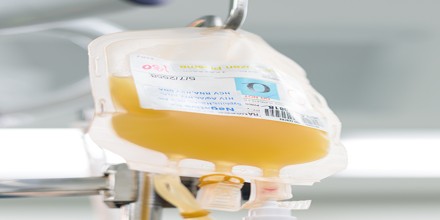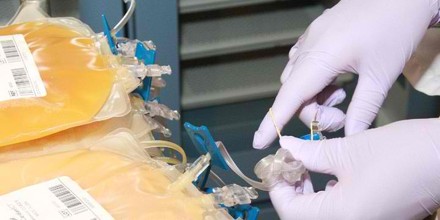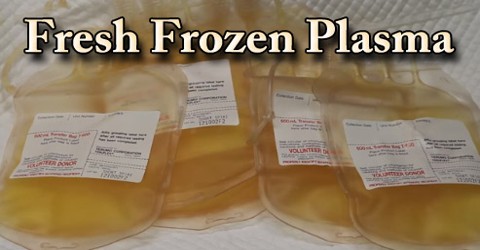FFP: Fresh Frozen Plasma
Definition
Fresh Frozen Plasma or FFP is made from plasma which is separated from donor blood and frozen to minus 35° Centigrade to preserve it. It colder within 8 hours of whole blood donation if the antigoagulant used was CPD, CD2D, or CPDA-1. If the preservative was ACD then within 6 hours. The specific batch typically needs to be tested for compatibility before it is given. Use as a volume expander is not recommended. It is given by injection into a vein.

One unit of Fresh Frozen Plasma (FFP) or thawed plasma is the plasma taken from a unit of whole blood. FFP contains all coagulation factors in normal concentrations. Thawed plasma may be transfused up to 5 days after thawing and contains slightly decreased levels of Factor V (66+/-9%) and decreased Factor VIII levels (41+/-8%). Plasma is free of red blood cells, leukocytes and platelets. One unit is approximately 250mL and must be ABO compatible. Rh factor need not be considered. Since there are no viable leukocytes, plasma does not carry a risk of CMV transmission or Graft vs. Host Disease (GVHD).
Plasma first came into medical use during the Second World War. It is on the World Health Organization’s List of Essential Medicines, the most effective and safe medicines needed in a health system. The phrase “FFP” is often used to mean any transfused plasma product. The other commonly transfused plasma, PF24, has similar indications as those for FFP with the exception of heat-sensitive proteins in the plasma such as factor V.

Uses of Fresh Frozen Plasma (FFP)
Fresh Frozen Plasma (FFP) is indicated for patients with a coagulopathy who are bleeding or at risk of bleeding, and where a specific therapy or factor concentrate is not appropriate or unavailable.
FFP may be indicated to replace labile plasma coagulation factors during massive transfusion, cardiac bypass, liver disease or acute disseminated intravascular coagulation in the presence of bleeding and abnormal coagulation.
It is appropriate to use FFP in cases of warfarin overdose with life threatening bleeding in addition to Prothrombinex Compex Concentrates (PCC) (vitamin K-dependent factor concentrates eg Prothrombinex-VF). Where PCCs are not available, FFP is suggested in patients with life threatening or clinically significant bleeding; and for urgent preoperative warfarin reversal.
Fresh Frozen Plasma is an accepted treatment for patients with thrombotic thrombocytopenic purpura often in conjunction with plasma exchange.

Indications for the use of FFP include the following:
Replacement of isolated factor deficiencies FFP is used to treat rare bleeding disorders when specific factor concentrates are not available. FFP is the usual treatment for factor V deficiency.
Reversal of warfarin effect Patients who are anticoagulated with warfarin are deficient in the functional vitamin K dependent coagulation factors II, VII, IX, and X, as well as proteins C and S. These functional deficiencies can be reversed by the administration of vitamin K. For anticoagulated patients who are actively bleeding or who require emergency surgery prothrombin complex concentrate should be used if available.[9] FFP (or single-donor plasma) should only be used if more effective alternative treatments are not available.
Use in antithrombin III deficiency FFP can be used as a source of antithrombin III in patients who are deficient of this inhibitor and are undergoing surgery or who require heparin for treatment of thrombosis.
Treatment of immunodeficiencies FFP is useful in infants with secondary immunodeficiency associated with severe protein-losing enteropathy and in whom total parenteral nutrition is ineffectual. FFP also can be used as a source of immunoglobulin for children and adults with humoral immunodeficiency. However, the development of a purified immune globulin for intravenous use largely has replaced Fresh frozen plasma
Treatment of thrombotic thrombocytopenic purpura FFP may be beneficial for the treatment of thrombotic thrombocytopenic purpura.

Do not use fresh frozen plasma in the following circumstances:
When people can correct coagulopathy effectively with specific therapy, such as vitamin K, cryoprecipitate, factor VIII or other specific factor concentrates
In plasma exchange procedures except for treatment in thrombotic thrombocytopenic purpura
Treatment of immunodeficiency states
When people can safely and adequately replace blood volumes with volume expanders, such as 0.9% Sodium Chloride Injection, Hartmann’s Solution, or appropriate colloids.
Dosage of Fresh Frozen Plasma (FFP)
The volume transfused depends on the clinical situation and patient size, and should be guided by laboratory assays of coagulation function. The general guide is 10–15 mL/kg per dose.
















